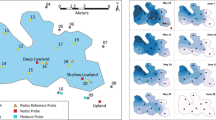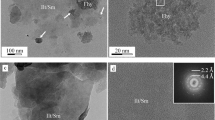Abstract
Purpose
Numerous extraction procedures have been used to characterize phosphorus (P) forms bound to iron (Fe) and aluminum (Al) (hydr)oxides in soils and sediments. We propose a simple modification of a widely used P fractionation method that more precisely quantifies P associated with active Fe and Al (hydr)oxides, which are mostly responsible for P binding and its potential release to water.
Materials and methods
We modified the original sequential extraction [H2O, bicarbonate-dithionite (BD), NaOH, HCl] by adding short (10-min) extractions with BD and NaOH prior to the respective original steps. The method was verified using (1) dissolution kinetics of Fe and Al minerals of different crystallinity and (2) liberation of P, Fe, and Al from natural samples of soils, sediments, and settling seston, containing different proportions of amorphous and crystalline Fe and Al (hydr)oxides. Extracted P was analyzed for reactive and non-reactive (mostly organic) P forms.
Results and discussion
Both mineral and organic P forms associated with Fe and Al were almost completely liberated from the samples during the 10-min BD and NaOH extractions, respectively. Prolonged extraction period caused a partial P re-adsorption onto the solid phase in some samples. The 10-min extractions were able to dissolve amorphous Fe and Al (hydr)oxides (ferrihydrite, amorphous AlOOH) and a portion of more crystalline Fe and Al minerals, approximately related to their surface area.
Conclusions
The additional short extraction steps allow a rapid and more precise quantification of P associated with active Al and Fe (hydr)oxides, and better estimate the amounts of these Fe and Al forms in soils and sediments than the original method. Our simple modification of the traditional method thus provides new and useful information for environmental studies focused on potential P mobility across a solid phase-water interface.





Similar content being viewed by others
References
Berkowitz J, Anderson MA, Amrhein C (2006) Influence of aging on phosphorus sorption to alum floc in lake water. Wat Res 40:911–916
Brunauer S, Emmett PH, Teller E (1938) Adsorption of gases in multimolecular layers. J Am Chem Soc 60:309–319
Cornell RM, Schwertmann U (2003) The iron oxides: structure, properties, reactions, occurrences and uses, 2nd edn. Wiley-VCH
De Groot CJ, Golterman HL (1993) On the presence of organic phosphate in some Camargue sediments: evidence for the importance of phytate. Hydrobiologia 252:117–126
De Vicente I, Huang P, Andersen FO, Jensen HS (2008) Phosphate adsorption by fresh and aged aluminum hydroxide. Consequences for lake restoration. Environ Sci Technol 42:6650–6655
Detenbeck NE, Brezonik PL (1991) Phosphorus sorption by sediments from a soft-water seepage lake. 2. Effects of pH and sediment composition. Environ Sci Technol 25:403–409
Föllmi KB (1996) The phosphorus cycle, phosphogenesis and marine phosphate-rich deposits. Earth Sci Rev 40:55–124
Fontes MPF, Weed SB (1996) Phosphate adsorption by clays from Brazilian oxisols: relationships with specific surface area and mineralogy. Geoderma 72:37–51
Hansen J, Reitzel K, Jensen HS, Andersen FØ (2003) Effects of aluminum, iron, oxygen and nitrate additions on phosphorus release from the sediment of a Danish softwater lake. Hydrobiologia 492:139–149
Houben G (2003) Iron oxide incrustations in wells. Part 2: chemical dissolution and modeling. Appl Geochem 8:941–954
Hupfer M, Zak D, Roßberg R, Herzog C, Pöthig R (2009) Evaluation of a well-established sequential phosphorus fractionation technique for use in calcite-rich lake sediments: identification and prevention of artifacts due to apatite formation. Limnol Ocean Methods 7:399–410
Jan J, Borovec J, Kopáček J, Hejzlar J (2013) What do results of common sequential fractionation and single-step extractions tell us about P binding with Fe and Al compounds in non-calcareous sediments? Wat Res 47:547–557
Jensen HS, Thamdrup B (1993) Iron-bound phosphorus in marine sediments as measured by bicarbonate-dithionite extraction. Hydrobiologia 253:47–59
Jensen HS, Caraco N, Hansen J, Christensen KK (2005) Humic-bound phosphorus in soil and sediment. In: Golterman HL, Serrano L (eds) Phosphate in sediments: proceedings of the 4th international symposium Carmona (Spain), 9–12 September 2003. Backhuys Publishers, Leiden, pp 99–107
Kaňa J, Kopáček J, Camarero L, Garcia-Pausas J (2001) Phosphate sorption characteristics of European alpine soils. Soil Sci Soc Am J 75:862–870
Kennedy RH, Cooke GD (1982) Control of lake phosphorus aluminium sulfate: Dose determination and application techniques. Wat Res Bull 18:389– 395
Kingston FJ, Posner AM, Quirk JP (1972) Anion adsorption by goethite and gibbsite. I. The role of the proton in determining adsorption envelopes. J Soil Sci 23:177–192
Kopáček J, Borovec J, Hejzlar J, Porcal P (2001a) Spectrophotometric determination of iron, aluminum, and phosphorus in soil and sediment extracts after their nitric and perchloric acid digestion. Commun Soil Sci Plant Anal 32:1431–1443
Kopáček J, Ulrich KU, Hejzlar J, Borovec J, Stuchlik E (2001b) Natural inactivation of phosphorus by aluminum in atmospherically acidified water bodies. Water Res 35:3783–3790
Kopáček J, Borovec J, Hejzlar J, Ulrich KU, Norton SA, Amirbahman A (2005) Aluminum control of phosphorus sorption by lake sediments. Environ Sci Technol 39:8784–8789
Kopáček J, Marešová M, Hejzlar J, Norton SA (2007) Natural inactivation of phosphorus by aluminum in preindustrial lake sediments. Limnol Ocean 52:1147–1155
Kopáček J, Hejzlar J, Kaňa J, Norton SA, Porcal P, Turek J (2009) Trends in aluminium export from a mountainous area to surface waters, from deglaciation to the recent: effects of vegetation and soil development, atmospheric acidification, and nitrogen-saturation. J Inorg Biochem 103:1439–1448
Lake T, Jin X, Wang S, Pang Y, Chang F (2006) Phosphorus fractions and the effect of pH on the phosphorus release of the sediments from different trophic areas. Environ Pollut 139:288–295
Lijklema L (1980) Interaction of orthophosphate with iron(III) and aluminum hydroxides. Environ Sci Technol 14:537–541
Lukkari K, Hartikainen H, Leivuori M (2007) Fractionation of sediment phosphorus revisited: I. Fractionation steps and their biogeochemical basis. Limnol Ocean Methods 5:433–444
Martynova MV (2010) Iron compound occurrence forms in freshwater deposits: analytical review. Wat Resour 37:488–496
McLaughlin JR, Ryden JC, Syers JK (1981) Sorption of inorganic phosphate by iron and aluminum containing components. J Soil Sci 32:365–377
Mortimer CH (1941) The exchange of dissolved substances between mud and water in lakes. J Ecol 29:280–329
Mortimer CH (1971) Chemical exchanges between sediments and water in the Great Lakes speculations on probable regulatory mechanisms. Limnol Ocean 16(2):387–404
Murphy J, Riley JP (1962) A modified single solution method for the determination of phosphate in natural waters. Analyt Chim Acta 27:31–36
Norton SA, Coolidge K, Amirbahman A, Bouchard R, Kopáček J, Reinhardt R (2008) Speciation of Al, Fe, and P in recent sediment from three lakes in Maine, USA. Sci Tot Environ 404:276–283
Ognalaga M, Frossard E, Thomas F (1994) Glucose-1-phosphate and myo-inositol hexaphosphate adsorption mechanisms on goethite. Soil Sci Soc Am J 58:332–337
Paludan C, Jensen HS (1995) Sequential extraction of phosphorus in freshwater wetland and lake sediment: significance of humic acids. Wetlands 15:365–373
Pierzynski GM (ed) (2000) Methods of phosphorus analysis for soils, sediments, residuals, and waters. Southern Cooperative Series Bulletin No. 396. URL, North Carolina State University
Postma D (1993) The reactivity of iron oxides in sediments: a kinetic approach. Geochim Cosmochim Acta 57:5027–5034
Psenner R, Pucsko R (1988) Phosphorus fractionation: advantages and limits of the method for the study of sediment P origins and interactions. Arch Hydrobiol Beih Ergebn Limnol 30:43–59
Qiu S, McComb A (2000) Properties of sediment phosphorus in seven wetlands of the Swan Coastal Plain, south-western Australia. Wetlands 20(2):267–279
Reitzel K, Ahlgren J, Gogoll A, Jensen HS, Rydin E (2006) Characterization of phosphorus in sequential extracts from lake sediments using 31 P nuclear magnetic resonance spectroscopy. Can J Fish Aquat Sci 63:1686–1699
Reitzel K, Jensen HS, Egemose S (2013) pH dependent dissolution of sediment aluminum in six Danish lakes treated with aluminum. Wat Res 47:1409–1420
Roden EE (2003) Fe(III) oxide reactivity toward biological versus chemical reduction. Environ Sci Technol 37:1319–1324
Roden EE, Zachara JM (1996) Microbial reduction of crystalline iron(III) oxides: influence of oxide surface area and potential for cell growth. Environ Sci Technol 30:1618–1628
Rydin E, Welch E (1999) Dosing Al to Wisconsin lake sediments based on possible formation of aluminum bound phosphate. Lake Reserv Manag 15:324–331
Rydin E, Huser B, Welch E (2000) Amount of phosphorus inactivated by Al treatments in Washington lakes. Limnol Ocean 45:226–230
Schwertmann U (1988) Some properties of soil and synthetic iron oxides. In: Stucki JW, Goodman BA, Schwertmann U (eds) Iron in soils and clay minerals SE—9. Springer, Netherlands, pp 203–250
Torrent J, Schwertmann U, Barron V (1987) The reductive dissolution of synthetic goethite and hematite in dithionite. Clay Min 22:329–337
Turner BL, Mahieu N, Condron LM (2003) Phosphorus-31 nuclear magnetic resonance spectral assignments of phosphorus compounds in soil NaOH–EDTA extracts. Soil Sci Soc Am J 67:497–510
Wetzel RG (2001) Limnology, lake and river ecosystems, 3rd edn. Academic Press
Zak D, Gelbrecht J, Wagner C, Steinberg CEW (2008) Evaluation of phosphorus mobilization potential in rewetted fens by an improved sequential chemical extraction procedure. Eur J Soil Sci 59:1191–1201
Acknowledgments
This study was supported by the Grant Agency of the Czech Republic (project no. 206/09/1764 and P504/13-17398S) with additional support by the Grant Agency of the University of South Bohemia (GAJU142/2010/P). We thank Dr. D. Sirová for proofreading.
Author information
Authors and Affiliations
Corresponding author
Additional information
Responsible editor: Brian Kronvang
Rights and permissions
About this article
Cite this article
Jan, J., Borovec, J., Kopáček, J. et al. Assessment of phosphorus associated with Fe and Al (hydr)oxides in sediments and soils. J Soils Sediments 15, 1620–1629 (2015). https://doi.org/10.1007/s11368-015-1119-1
Received:
Accepted:
Published:
Issue Date:
DOI: https://doi.org/10.1007/s11368-015-1119-1




